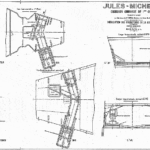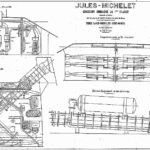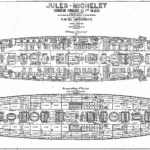 France. Armored Cruiser built 1904-1908, service until 1937.
France. Armored Cruiser built 1904-1908, service until 1937.WW1 French Cruisers
Sfax | Tage | Amiral Cecille | D'Iberville class | Dunois class | Foudre | Davout | Suchet | Forbin class | Troude class | Alger class | Friant class | Linois class | Descartes class | D'Assas class | D’Entrecasteaux | Protet class | Guichen | Chateaurenault | Chateaurenault | D'Estrées class | Jurien de la Graviere | Lamotte-Picquet classDupuy de Lome | Amiral Charner class | Pothuau | Jeanne d'Arc | Gueydon class | Dupleix class | Gloire class | Gambetta class | Jules Michelet | Ernest Renan | Edgar Quinet class
Jules Michelet was an evoliution of the previous Leon Gambetta armoured cruiser design, fitted with better boilers for more power, extra speed, and more modern marks of guns and revised armament in general. Jules Michelet had a relatively long career. Completed at Lorient Arsenal on the west coast in 1908, she entered service with the Mediterranean fleet, seeing action in the first world was as part of the 1st light division (With Renan and Quinet) for various operations in the Adriatic, North Africa, and salonika campaign. Postwar she was in Indochina as flagship until 1929, then a barrack ship and target ship in Toulon in 1937.

Development
Jules Michelet was one of the last French armoured cruisers ever built (if we make an exception for Algerie in 1931). She succeeded to the Léon Gambetta class as a one-off all around improvement based on a higher displacement, and succeeded b the larger Ernest Renan launched in 1906 and Edgar Quinet class launched in 1907-1908. The latter reached 14,000 tonnes and were heavily armed, with a uniform battery of fourteen QF 7.6-inch guns whereas Michelet had only four. She was an interesting transition towards the pinnacle of a development, with ships able to defend far flung outposts in the Empire, hunt down enemy trade, and take their place in a battle line if needed.
Jules Michelet was the result of unsatisfaction in the Marine Nationale about the speed of its cruisers. She was designed, under the direction of Bertin as a modified version of the Leon Gambetta class but slightly longer, still with similar machinery layout, with 28 boilers which made for 1,500 ihp (1,100 kW) more power than the Gambettas, reaching 22.5 knots (41.7 km/h; 25.9 mph) instead of 22, and still four funnels. But apart that, she shared the same armament as the Gambettas.
Ernest Renan was initially planned as the fourth ship in the Gambetta class, but naval architect Emile Bertin decided to modify the design in an attempt to further increase her speed. For this, he stretched the hull to incorporate additional boilers (a staggering 42 total, exhausted into six funnels). This made for 37,000 ihp and 23 knots. The next Quinet would be essentially close sisters.
Design of the class
Hull and general design
Essentially the Michelet was a “larger” (not longer) version of the Gambettas, displacing 13,105 t (12,898 long tons) for an overal lenght of 146.53 m (480 ft 9 in) and a beam of 21.41 m (70 ft 3 in), Draught of 8.41 m (27 ft 7 in) versus 12,500t, 148 m long, 21.4 m (70 ft 3 in) wide and 8.18 m (26 ft 10 in) in draft. As seen here, she was just deeper. This improved buoyancy, and stability as well. This margin enabled so top weight additions, notably in armament, and larger boilers.
Powerplant
Unlike the Gambettas which mixed 20 or 28 boilers of various types with VTE steam engines, Jules Michelet was heavier, and combined like the previous ships a triple shaft arrangement with three vertical triple expansion steam engines fed in turn by 28 Guyot du Temple boilers, for a total of 30,000 ihp (22,371 kW) instead of 27,500 PS (20,226 kW). The next increase benefited top speed by just half a knot, at 22.5 knots (41.7 km/h; 25.9 mph) versus 22 knots.
For range she carried 2,070 tonnes of coal versus 2065 tonnes, for a range of 7,500 nmi (13,900 km; 8,600 mi) at 10 knots (19 km/h; 12 mph) versus 6,600 at the same speed, so a net increase, mostly due to the greater efficience of the boilers.

The French squadron led by Michelet (German Lithography)
Protection
The armor scheme was about the same, here are the two stats layed here:
Gambettas: Belt: 70-150, turrets: 200, barbettes 100-180, secondary turrets 130-165, barbettes 65-130, casemates: 140, lower deck 45-65 and main deck 35, CT 200mm
Michelet: Belt: 70-150, turrets: 200, barbettes 100-180, secondary turrets 130-165, barbettes 65-130, casemates: 140, lower deck 45-65 and main deck 35, CT 200mm

From Pinterest
Armament
There were changes here as well: Albeit the main armament was unchanged with four 194 mm (7.6 in) guns in twin turrets fore and aft, the secondary armament comprised twelve (instead of fifteen on the Gambettas) 164 mm (6.5 in) guns, eight in single turrets (six twin turrets on the Ganbettas) and remaining four in casemates (like the Gambettas). The swap from twin to single turrets seemslike a drawback, as well as the loss of foire guns. However this was made for two reasons:
The new secondary guns had the same caliber but were of a new model, quicker firing and with greater range and muzzle velocity, but taking more space and weight so for weight distribution reasons, only single turrets were possible.
The second reason was that even if placed in new twin turrets, they could have cause extra topweight.
Now between the single, lighter turrets and increase draft they ended as better, more stable gun platforms with lower metacentric height.
This was completed by a tertiary anti-torpedo-boat battery of twenty four 47 mm (1.9 in) guns, all mounted in casemates.
There were also two submerged 450 mm (17.7 in) torpedo tubes. They were almost an afterthought, so no attention will be paid there.
194 mm/50 (7.6 in) M1902

On the cruiser Waldeck Rousseau.
These were similar in caliber, but more powerful models than those carried in the earlier ships. The 50 caliber (instead of the 194/45 Modèle 1893–1896) had far better caracteristics. It was shared with the cruisers Renan, the two Quinet class and the Liberté class battleships.
Cerectersitics: 15 t (17 short tons), 10.1 meters (33 ft) long, barrel 9.7 meters (32 ft) 50 caliber
Shell: 89.5 kg (197 lb) separate-loading, bagged charge HE/AP mv 940 m/s (3,100 ft/s)
Elevation: -6° to +15°, traverse: -150° to +150°
Rate of fire: 2 rpm
Best range: 26 km (16 mi) at 45°

164mm/50 M1902
Not the same as the previous Gambetta class cruisers. Again, better than the Modele 1893-96 45 caliber. It was used on the Démocratie, Edgar Quinet, Ernest Renan and Jules Michelet.
Weight: 33,470 lbs. (15,180 kg), 398.0 in (10.110 m) bore 381.9 in (9.700 m)
Rate Of Fire: About 2 rounds per minute
Round: APC M1902 – 189.6 lbs. (86 kg) or SAPC M1902 – 194.0 lbs. (88 kg), separate, bagged, mv 3,117 fps (950 mps)
Range at 15° (max turret): 12,580 yards (11,500 m)
More on navweaps
QF 3 Pdr (47 mm) Hotchkiss M1885
Twenty Four in all, spread between casemated positions along the hull,
Specs: 240 kg (530 lb), 2 m (6 ft 7 in) barrel 1.8 m (5 ft 11 in) 40 caliber
Shell: Fixed QF 47 × 376 mm R 3 kg (6.6 lb), mv 571 m/s (1,870 ft/s)
Vertical sliding-wedge breech, 30 rpm, Range 5.9 km (3.7 mi) at +20°
⚙ specifications |
|
| Displacement | 13,105 t (12,898 long tons) standard |
| Dimensions | 146.53x 21.41 x 8.41 m (480 ft 9 in x 70 ft 3 in x 27 ft 7 in) |
| Propulsion | 3 shafts VTE, 28 Guyot du Temple boilers: 30,000 ihp (22,371 kW) |
| Speed | 22.5 knots (41.7 km/h; 25.9 mph) |
| Range | 2,070 tonnes of coal, 6600 nm/10 kts |
| Armament | 2×2 194 mm M1902, 12× 164 mm M1893-96M, 24× 47 mm, 2× 450 mm sub TTs |
| Protection | 71–152 mm belt, 200 mm main, 130–170 mm sec. turrets, casemates 140 mm, CT 200 mm |
| Crew | 728 |
Career of Jules Michelet

After entering service, Jules Michelet was placed in the cruiser squadron of the Mediterranean Fleet in Toulon. On 27 June 1912 during firing practice at Toulon, she had two gun explosions, killing 4, wounding 21, blamed on defective powder.
When the First World War broke up, she remained in the Mediterranean’s 1st light cruiser division, with Ernest Renan and Edgar Quinet, tasked to hunt down Admiral Souchon’s Med squadron, with SMS Goeben and Breslau. The division patrolled off North Africa preceded by twelve destroyers, heading for Philippeville on 4 August, until learning the citt had been shelled on the 3th by Souchon. Many reports also came out which suggested they would try to break out of the Mediterranean and head for home, to the French high command sent the division further west of Algiers to block the their path, but this never happened. Instead, they headed for Constantinople and did not preyed on French troopships to France.

The cruiser’s staff during the operation in Corfu
The division was sent to face the Austro-Hungarian Navy in the Adriatic, joined by Edgar Quinet to start a blockade, based in Navarino and under fleet commander Admiral Augustin Boué de Lapeyrère. They made a sweep on 16 August into the Adriatic until spotting SMS Zenta. This became the Battle of Antivari, and Zenta was sunk. The sweep stopped with the fleet withdrawing due to Austro-Hungarian U-boats being suspected on the area.
Later in the war, Jules Michelet lost all her 47 mm guns for just four 47 mm anti-aircraft guns (AA mount version of the Hotchkiss). She took part in the evacuation of the Serbian army from Corfu to Bizerta in 1915. Later she tupported the Allied operations, Salonika campaign. After the Armistice of Mudros she was sent through the Dardanelles and in the Black Sea by November 1918, entering the gold horn.



Photos taken in and out of Saigon, and Tanjong Priok in 1929, close to her decommission
Postwar she was sent to French Indochina in 1922–1923 with Victor Hugo, leaving France on 12 October 1922, arriving on 19 April 1923 and staying in East Asian waters until 10 May, back in Toulon on 11 July. She would return as flagship with the Far East squadron, leaving Toulon on 15 June 1925, arriving in July and staying until replaced by Waldeck-Rousseau until May 1929, back home on 10 July 1929, paid off, placed in reserve, disarmed in 1930. No longer listed as cruiser, striken 1931, reaffected as barracks ship at Toulon. She was reassigned as target ship for aircraft and submarines. She was sunk by the submarine Thétis in 1937.
Read More/Src
Books
Corbett, Julian Stafford (1920). Naval Operations: To The Battle of the Falklands, December 1914. Green & Co.
Dai, Wei (September 2020). “A Discussion on French Armored Cruiser Identification. Warship International.
Earle, Ralph, ed. (1912). “Professional Notes”. Proceedings. Vol. 38, no. 1. NIP
“Explosions on French Warships”. The Colonist. LIV (13458). Nelson, New Zealand 2 July 1912.
Gardiner, Robert, ed. (1979). Conway’s All the World’s Fighting Ships 1860–1905. Conway Maritime Press.
Gardiner, Robert; Gray, Randal, eds. (1985). Conway’s All the World’s Fighting Ships 1906–1921. NIP
Jordan, John & Caresse, Philippe (2019). French Armoured Cruisers 1887–1932. Barnsley, Seaforth Publishing
Jordan, John & Moulin, Jean (2013). French Cruisers 1922–1956. Barnsley Seaforth Publishing
Purnell’s Illustrated Encyclopedia of Modern Weapons and Warfare. London: Phoebus Pub. Co. 1978.
Moore, John (1990). Jane’s Fighting Ships of World War I. London: Studio.
McMurtrie, Francis Edwin (1931). Jane’s Fighting Ships 1931. Newton Abbot: Davis & Charles Reprints.
The Times History of the War: Vol. XXI. London, 1920.
Links
worldnavalships.com/
navypedia.org/
en.wikipedia.org/ French_cruiser_Jules_Michelet
fr.wikipedia.org/ Jules_Michelet
francearchives.gouv.fr/
3dhistory.de
shipspotting.com/
shipsnostalgia.com/































 Latest Facebook Entry -
Latest Facebook Entry -  X(Tweeter) Naval Encyclopedia's deck archive
X(Tweeter) Naval Encyclopedia's deck archive Instagram (@navalencyc)
Instagram (@navalencyc)





 French Navy
French Navy Royal Navy
Royal Navy Russian Navy
Russian Navy Armada Espanola
Armada Espanola Austrian Navy
Austrian Navy K.u.K. Kriegsmarine
K.u.K. Kriegsmarine Dansk Marine
Dansk Marine Nautiko Hellenon
Nautiko Hellenon Koninklije Marine 1870
Koninklije Marine 1870 Marinha do Brasil
Marinha do Brasil Osmanlı Donanması
Osmanlı Donanması Marina Do Peru
Marina Do Peru Marinha do Portugal
Marinha do Portugal Regia Marina 1870
Regia Marina 1870 Nihhon Kaigun 1870
Nihhon Kaigun 1870 Preußische Marine 1870
Preußische Marine 1870 Russkiy Flot 1870
Russkiy Flot 1870 Svenska marinen
Svenska marinen Søværnet
Søværnet Union Navy
Union Navy Confederate Navy
Confederate Navy Armada de Argentina
Armada de Argentina Imperial Chinese Navy
Imperial Chinese Navy Marinha do Portugal
Marinha do Portugal Mexico
Mexico Kaiserliche Marine
Kaiserliche Marine 1898 US Navy
1898 US Navy Sovietskiy Flot
Sovietskiy Flot Royal Canadian Navy
Royal Canadian Navy Royal Australian Navy
Royal Australian Navy RNZN Fleet
RNZN Fleet Chinese Navy 1937
Chinese Navy 1937 Kriegsmarine
Kriegsmarine Chilean Navy
Chilean Navy Danish Navy
Danish Navy Finnish Navy
Finnish Navy Hellenic Navy
Hellenic Navy Polish Navy
Polish Navy Romanian Navy
Romanian Navy Turkish Navy
Turkish Navy Royal Yugoslav Navy
Royal Yugoslav Navy Royal Thai Navy
Royal Thai Navy Minor Navies
Minor Navies Albania
Albania Austria
Austria Belgium
Belgium Columbia
Columbia Costa Rica
Costa Rica Cuba
Cuba Czechoslovakia
Czechoslovakia Dominican Republic
Dominican Republic Haiti
Haiti Hungary
Hungary Honduras
Honduras Estonia
Estonia Iceland
Iceland Eire
Eire Equador
Equador Iran
Iran Iraq
Iraq Latvia
Latvia Liberia
Liberia Lithuania
Lithuania Mandchukuo
Mandchukuo Morocco
Morocco Nicaragua
Nicaragua Persia
Persia San Salvador
San Salvador Sarawak
Sarawak Uruguay
Uruguay Venezuela
Venezuela Zanzibar
Zanzibar Warsaw Pact Navies
Warsaw Pact Navies Bulgaria
Bulgaria Hungary
Hungary

 Bundesmarine
Bundesmarine Dutch Navy
Dutch Navy Hellenic Navy
Hellenic Navy Marina Militare
Marina Militare Yugoslav Navy
Yugoslav Navy Chinese Navy
Chinese Navy Indian Navy
Indian Navy Indonesian Navy
Indonesian Navy JMSDF
JMSDF North Korean Navy
North Korean Navy Pakistani Navy
Pakistani Navy Philippines Navy
Philippines Navy ROKN
ROKN Rep. of Singapore Navy
Rep. of Singapore Navy Taiwanese Navy
Taiwanese Navy IDF Navy
IDF Navy Saudi Navy
Saudi Navy Royal New Zealand Navy
Royal New Zealand Navy Egyptian Navy
Egyptian Navy South African Navy
South African Navy






























 Ukrainian Navy
Ukrainian Navy dbodesign
dbodesign